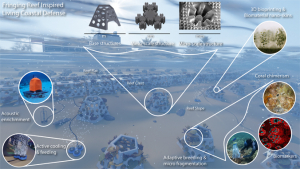The University of Hawaiʻi will be awarded up to $25 million by the Defense Advanced Research Projects Agency (DARPA) to develop an engineered coral reef ecosystem to help protect coastlines from flooding, erosion and storm damage. The goal of the five-year project, inspired by natural reefs, is to create an engineered structure that dissipates wave energy while providing habitat for corals and other reef life.
The ground-breaking project is a joint effort between UH Mānoa’s School of Ocean and Earth Science and Technology (SOEST) and the UH Applied Research Laboratory (ARL).

“The Rapid Resilient Reefs for Coastal Defense (R3D) project will be the first of its kind by taking an integrated, ecosystem-level approach to design and build a living coastal-protection system,” said Ben Jones, R3D principal investigator and Director of Ocean Science and Technology at ARL. “This is an immense challenge. We have assembled a team of experts right here in Hawaiʻi who, in partnership with Florida Atlantic University and Scripps Institution of Oceanography, will devise real solutions that will help our community and other communities around the tropical Pacific that are already facing the effects of climate change.”
Sea-level rise and wave-induced flooding during increasingly frequent storm events threaten the sustainability of coastlines and more than 1,700 U.S. Department of Defense-managed military installations in coastal areas worldwide. Natural coral reefs provide substantial protection to shorelines—absorbing and dissipating the intense energy from storms and waves. As sea level rises and coral reef degrades, existing storm mitigation solutions may prove insufficient and damage due to storm surge and flooding will continue to impact communities and infrastructure.
“This award will enable our world-class experts to develop advanced technology that will have a significant impact here in Hawaiʻi, and around the world,” said UH Mānoa Provost Michael Bruno. “We are proud to have UH research at the cutting edge of creating a solution to a global problem.“
Partnering engineering, ecology and biology
The new project integrates coastal engineering and hydrodynamics with expertise on coral reef ecology and adaptive biology to enable the team to rapidly develop a living, breakwater system that can adapt to both rising seas and increasing ocean temperatures.

“The typical fringing reef consists of a fore reef along the slope, a reef crest that absorbs much of the wave energy and a protected back reef that harbors more delicate species,” said Zhenhua Huang, SOEST professor of Ocean and Resources Engineering and lead investigator for base structure engineering. “We intend to achieve similar wave attenuation using perforated, thin-walled base structures which are low-cost, efficient energy dissipators. It’s our hope that this project can provide a win-win solution for addressing preservation of nearshore marine natural resources and shore protection.”
Healing corals over time
Establishing coral and other reef supporting organisms on the reef structures is critical to ensuring the structures have the capability to grow and heal over time. Fragments from known thermally tolerant colonies will be attached to succession modules, reef-mimicking structures that will be attached to the wave-attenuating base structures. Larvae from known thermally tolerant coral species will also be encouraged to make their home on these structures.
- See more on UH coral reef research.
“Designing succession modules that attract coral larvae, and then protect them from being eaten or overgrown by algae, is essential for kick-starting a living reef,” said Josh Madin, associate research professor in the Hawaiʻi Institute of Marine Biology (HIMB) in SOEST and lead investigator for ecosystem engineering. “Larvae are really bad swimmers, and so they need to be captured by cracks and crannies in the structure. We will use 3D design and biofilm chemistry to attract larvae and encourage settlement, while discouraging algae growth. On top of this, we will use sounds that mimic a healthy reef to attract organisms that help coral growth.”
Additionally, the team will explore cost-effective ways to supplement feeding for bleached corals and even actively shade or cool the reef in the early stages of the reef development and during marine heat waves.
“Coral reefs across the planet are declining from the combined assaults of human impacts,” said Rob Toonen, HIMB professor and lead investigator for adaptive biology. “This project builds on over a decade of research at HIMB into practical solutions for farming thermally tolerant corals capable of withstanding those assaults and rebuilding the reef structure that protects our coastal roads, runways, and neighborhoods.”
The project is already garnering local support as an alternative to artificial coastal protection systems.
Rocky Kaluhiwa, president of the Koʻolaupoko Hawaiian Civic Club, said, “The Koʻolaupoko Hawaiian Civic Club strongly supports an approach like this, because it respects our traditional ways to manage our ʻaina and kai, finding a balance between the seas and the land.”
The team will be collaborating with scientists and engineers at Makai Ocean Engineering on Oʻahu, Florida Atlantic University, Scripps Institution of Oceanography at the University of California, San Diego and Ohio State University. Additional partnerships will also facilitate various aspects of this project. To scale up this revolutionary effort, Makai Ocean Engineering, a Hawaiʻi-based company, will handle major construction, anchoring and installation; and an Australian firm, Reef Design Labs, will create flexible, reusable forms to build hundreds of the succession modules.
–By Marcie Grabowski

